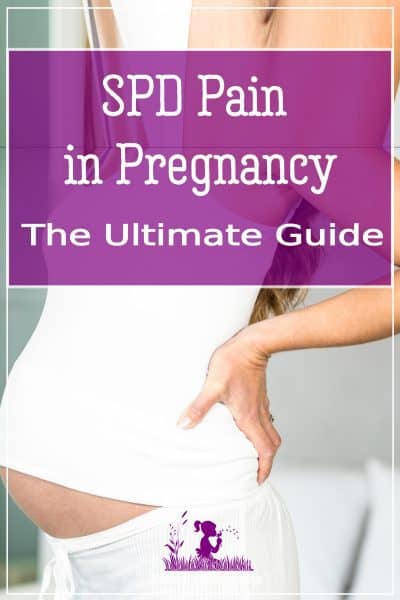 Symphysis Pubis Dysfunction in pregnancy (known at SPD) is many pregnant women’s worst nightmare. SPD is sharp, shearing pain of the pelvic girdle, hips, or groin area.
Symphysis Pubis Dysfunction in pregnancy (known at SPD) is many pregnant women’s worst nightmare. SPD is sharp, shearing pain of the pelvic girdle, hips, or groin area.
What does SPD mean in pregnancy?
Your pelvis is mainly formed of two pubic bones that curve round to make a cradle shape. The pubic bones meet at the front of your pelvis, at a firm joint called the symphysis pubis.
Please read: This information is provided for educational purposes only and is not intended to treat, diagnose or prevent any disease. We encourage you to make your own health care decisions in partnership with a qualified health care professional.
This post contains affiliate links, this means at no extra cost to you, we make a commission from sales. Please read
our Disclosure Statement
This join is held together by firm ligaments. During pregnancy swelling, and the hormone relaxin affect all your joints making them more lose and flexible.
Symphysis Pubis Dysfunction is where this join is no longer stable, and the joint shears against itself causing sharp, stabbing pain. SPD is usually diagnosed by a physician or physiotherapist.
Any type of pelvic pain in pregnancy is referred to as Pelvic Girdle Pain (PGP). Symphysis Pubis Dysfunction is one sub-type of PGP.
SPD Symptoms in Pregnancy
The symptoms of Symphysis Pubis Dysfunction do vary from woman to woman and pregnancy to pregnancy.
- Back pain, pain at the back of your pelvis or hip pain.
- Pain in your pubic area.
- A grinding or clicking sensation in your pelvis
- Stabbing pain down the inside of your thighs or between your legs.
- An increase in pain when you are parting your legs, walking, pushing a vacuum cleaner or shopping trolley, going up or down stairs or moving around in bed.
- Generally the pain is worse at night and affects your sleep.
- Pain in the front center of your pubic bone
- Pain in your lower back on one or both sides
- Pain in between your anus and vagina (perineum)
The SPD pain is usually more obvious when you are walking, pushing or pulling something, using stairs, rolling in bed or getting in and out of a car.
RELATED POST: Preventing complication in pregnancy
What causes SPD in pregnancy?
The most common cause for SPD is pregnancy, but it is sometimes just something people get.
When you are pregnant, one of the many hormones that your body releases is one called relaxin. Relaxin’s role is to loosen your joints to allow easier passage of your baby during birth.
Unfortunately, while this loosening is supposed to happen just before the birth, it can begin much earlier.
Strong muscle tone can compensate for the looser joints, and SPD is thought to happen when your body doesn’t adapt so well to the stretchier, looser ligaments.
SPD pains can be triggered by:
- Any joints in your pelvis moving unevenly
- A change in the way your muscles work to support your pelvic girdle joints
- Your back, posture or one pelvic joint not working properly can result in pain in the other joints of your pelvis
SPD means that your pelvis is not as stable as it would usually be
You are more likely to develop SPD in this pregnancy if:
- You have had pelvic joint pain before you became pregnant
- You’ve had a previous injury to your pelvis
- You’ve have had SPD before
- You are overweight
- You already have hypermobility in all your joints
RELATED: 10 Crazy + surprising pregnancy side effects
Diagnosing SPD early can be really helpful in managing the condition.
If you are pregnant and experiencing SPD symptoms, talk to your doctor or midwife. They will be able to refer you to a physiotherapist who can make an assessment of the stability and strength of your joints and pelvic muscles.
A physio can also give your strategies and exercises to help.
RELATED POST: Birth plans and free PDF
Is SPD common in pregnancy?
SPD may affect up to 1 in 5 pregnant women in some way. If you have had it before, you are more likely to get it again.
Can you get SPD in early pregnancy?
Yes, SPD can rare its ugly head at any point during a pregnancy. If you have had SPD in a previous pregnancy, you are more likely to get it again, and earlier than you did last time.
SPD can start as early as 6 weeks in to your pregnancy, or up to 4 weeks after you have your baby.
SPD can occur at anytime during pregnancy or immediately after the birth.
Is SPD dangerous in pregnancy?
SPD will not harm your baby, and is not a reason in most cases to not go on and have a natural birth. In fact, the upside to SPD is that the pelvis is super mobile, making it slightly easier to fit a baby through.
The ongoing, chronic pain during pregnancy can affect the mother-to-be’s mood, and she may struggle with feelings of depression and uselessness.
Generally, once you have had your baby, the relaxin levels will drop, and your pelvis will return to normal.
How do I relieve pelvic pain during pregnancy?
Pain relief is more difficult with SPD as it is not generally a constant ache, it is more of a quick shooting pain, then it is gone again. The pain when it happens can be so severe that the woman cries out, her legs give-way or she faints.
There are some movements that are known to make SPD worse, or to cause flares, so avoid doing these as much as you can:
- Moving your weight on to only one leg
- Twisting or bending while lifting anything
- Carrying a child on one of your hips
- Sitting with your legs crossed
- Sitting on the floor
- Sitting twisted or off center
- Standing, walking or sitting for long periods of time
- Lifting anything heavy, such as wet washing, shopping bags, or a child
- Vacuuming
- Pushing heavy objects, such as a shopping cart or pushchair
- Carrying bags or anything in only one hand
Be as active as you can, but don’t push yourself so far that it hurts. Unlike sciatica, SPD is aggravated and made worse by movement.
Make sure you do the pelvic floor and tummy exercises that your physiotherapist recommends.
Around the house ask for and accept offers of help with daily chores including the vacuuming, washing and bringing in the shopping.
Keep your knees together. Take care to part your legs no further than your pain-free range, particularly when getting in and out of the car, bed or bath.
Use common sense, if something hurts, stop doing it. If the pain is allowed to flare up, it can take a days to settle down again.
When you sleep, do so on your side with legs bent and a pillow between your knees.
Do your best to rest regularly or sit down for activities you would normally do standing.
If you need to climb stairs, take them one step at a time. Step up onto one step with your best leg and then bring your other leg to meet it.
Avoid standing on one leg as much as you can. When you are getting dressed, sit down to step in to your knickers or trousers.
Wear a support belt as much as you can, especially when walking. Wear it low, so it holds your hips together firmly.
RELATED POST: How to have a natural labor with less pain
How do you treat SPD?
The main course of treatment for SPD is Physiotherapy. The goal of this physiotherapy is to minimize your pain, strengthen your muscles, and improve your pelvic joint stability and position.
A physiotherapist can provide some manual therapy or massage to ensure that the joints in your pelvis, spine, and hips move normally.
They will also recommend to you exercises to strengthen the muscles in your pelvic floor, back, stomach, and hips.
In severe cases of SPD, pain-relief medications may be prescribed. You may also be provided with crutches or pelvic support belts.
Your physiotherapist should also advise you on how to make your daily activities less painful and on how to make the birth of your baby easier. Also your midwife should help you to write a birth plan that takes into account your SPD symptoms.
Acupuncture may help reduce the SPD pain and it is safe to use during pregnancy. Other manual therapies, such as osteopathy may help. Make sure you see a registered practitioner who is experienced in treating pregnant women.
What is the difference between sciatica and SPD
SPD is often misdiagnosed as sciatica. This is unfortunate for a pregnant woman, as the treatments are almost opposite to each other. It is also possible to have both sciatica and Symphysis Pubis Dysfunction.
Symphysis Pubis Dysfunction is the loosening and instability of the pelvic joints. The treatments involve minimizing movement and restricting exercise that puts pressure on the pelvis.
Sciatica is a trapped or aggravated sciatic nerve. The classic symptoms of sciatica is a shooting lightening fast pain down the buttock on one or both sides, often shooting down in to the leg.
Spd is triggered by pregnancy because of the hormones that is released but sciatica is not just caused by pregnancy, it can happen anytime for any reason.
Treating sciatic pain is related to stretching and movement. So it is important that you get the correct diagnosis before you start a treatment plan, as what works for one, will likely make the other condition worse.
If you find that you are suffering from pelvic pain during pregnancy, I urge you to see your health professional and get help and support as early as you can.




